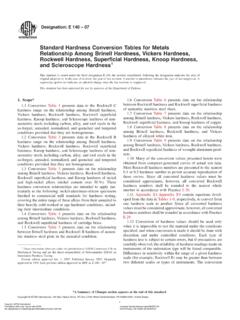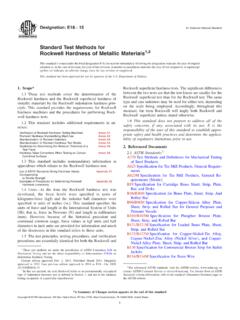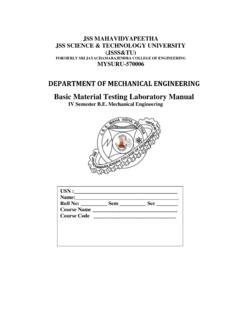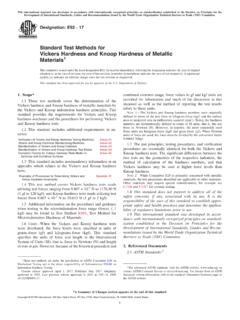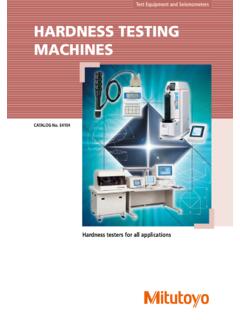Transcription of Standard Hardness Conversion Tables for Metals ...
1 This international Standard was developed in accordance with internationally recognized principles on standardization established in the Decision on Principles for the Development of International Standards, Guides and Recommendations issued by the World Trade Organization Technical Barriers to Trade (TBT) Committee. Designation: E140 12b 1. Standard Hardness Conversion Tables for Metals Relationship Among Brinell Hardness , vickers Hardness , Rockwell Hardness , Superficial Hardness , Knoop Hardness , Scleroscope Hardness , and Leeb Hardness1.
2 This Standard is issued under the fixed designation E140; the number immediately following the designation indicates the year of original adoption or, in the case of revision, the year of last revision. A number in parentheses indicates the year of last reapproval. A. superscript epsilon ( ) indicates an editorial change since the last revision or reapproval. This Standard has been approved for use by agencies of the Department of Defense. 1 NOTE Eq and Eq were editorially corrected in August 2013. 1. Scope* Conversion Table 5 presents data on the relationship between Brinell Hardness and Rockwell B Hardness of auste- Conversion Table 1 presents data in the Rockwell C.
3 Nitic stainless steel plate in the annealed condition. Hardness range on the relationship among Brinell Hardness , vickers Hardness , Rockwell Hardness , Rockwell superficial Conversion Table 6 presents data on the relationship Hardness , Knoop Hardness , and Scleroscope Hardness of non- between Rockwell Hardness and Rockwell superficial Hardness austenitic steels including carbon, alloy, and tool steels in the of austenitic stainless steel sheet. as-forged, annealed, normalized, and quenched and tempered Conversion Table 7 presents data on the relationship conditions provided that they are homogeneous.
4 Among Brinell Hardness , vickers Hardness , Rockwell Hardness , Conversion Table 2 presents data in the Rockwell B Rockwell superficial Hardness , and Knoop Hardness of copper. Hardness range on the relationship among Brinell Hardness , Conversion Table 8 presents data on the relationship vickers Hardness , Rockwell Hardness , Rockwell superficial among Brinell Hardness , Rockwell Hardness , and vickers Hardness , Knoop Hardness , and Scleroscope Hardness of non- Hardness of alloyed white iron. austenitic steels including carbon, alloy, and tool steels in the as-forged, annealed, normalized, and quenched and tempered Conversion Table 9 presents data on the relationship conditions provided that they are homogeneous.
5 Among Brinell Hardness , vickers Hardness , Rockwell Hardness , and Rockwell superficial Hardness of wrought aluminum prod- Conversion Table 3 presents data on the relationship ucts. among Brinell Hardness , vickers Hardness , Rockwell Hardness , Rockwell superficial Hardness , and Knoop Hardness of nickel Conversion Table 10 presents data in the Rockwell C. and high-nickel alloys (nickel content over 50 %). These Hardness range on the relationship among Leeb (Type D). Hardness Conversion relationships are intended to apply par- Hardness , Brinell Hardness , vickers Hardness , and Rockwell ticularly to the following.
6 Nickel-aluminum-silicon specimens Hardness of non-austenitic steels including carbon, alloy, and finished to commercial mill standards for Hardness testing, tool steels in the as-forged, annealed, normalized, and covering the entire range of these alloys from their annealed to quenched and tempered conditions provided that they are their heavily cold-worked or age-hardened conditions, includ- homogeneous. ing their intermediate conditions. Many of the Conversion values presented herein were Conversion Table 4 presents data on the relationship obtained from computer-generated curves of actual test data.
7 Among Brinell Hardness , vickers Hardness , Rockwell Hardness , Most Rockwell Hardness numbers are presented to the nearest and Rockwell superficial Hardness of cartridge brass. or Hardness number to permit accurate reproduction of these curves. Annex A1 Annex A10 contain equations to convert 1. These Conversion Tables are under the jurisdiction of ASTM Committee E28 on from one Hardness scale to another. The equations given in Mechanical Testing and are the direct responsibility of Subcommittee on Annex A1 Annex A9 were developed from the data in Tables Task Group on the Development of E140 Conversion Tables for Ni-Cr-Mo 1 to 9, respectively.
8 The equations given in Annex A10 were Precipitation Hardened Alloys and Martensitic Stainless Steels. developed at the time the Leeb Hardness test was invented (see Current edition approved Dec. 1, 2012. Published May 2013. Originally approved in 1958. Last previous edition approved in 2012 as E140 12a. DOI: Appendix X2). The data in Table 10 was calculated from the Annex A10 equations. *A Summary of Changes section appears at the end of this Standard Copyright ASTM International, 100 Barr Harbor Drive, PO Box C700, West Conshohocken, PA 19428-2959.
9 United States Copyright by ASTM Int'l (all rights reserved); Tue Mar 21 23:08:49 EDT 2017. 1. Downloaded/printed by (USP) Universidade de Sao Paulo ((USP) Universidade de Sao Paulo) pursuant to License Agreement. No further reproductions authorized. E140 12b 1. Conversion of Hardness values should be used only to the results of tests using tungsten carbide balls. when it is impossible to test the material under the conditions specified, and when Conversion is made it should be done with 4. Apparatus and Reference Standards discretion and under controlled conditions.
10 Each type of The apparatus and reference standards shall conform to Hardness test is subject to certain errors, but if precautions are the description in Test Methods A956, E10, E18, E384, and carefully observed, the reliability of Hardness readings made on Practice E448. instruments of the indentation type will be found comparable. Differences in sensitivity within the range of a given Hardness 5. Principle of Method of Conversion scale (for example, Rockwell B) may be greater than between tests have proved that even the most reliable data two different scales or types of instruments.

